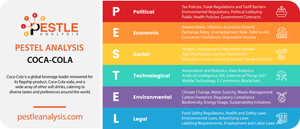Our PESTLE analysis of Coca-Cola discusses the Political, Economic, Social, Technological, Legal, and Environmental factors affecting Coca-Cola.
Coca-Cola stands as a global titan in the soft drink industry, delighting customers across every corner of the globe with its iconic beverages. To consistently deliver its products, the company rigorously follows stringent regulations, meets diverse and evolving consumer expectations, and harnesses cutting-edge technology.
Why PESTLE Analysis is Important for Coca-Cola
PESTLE analysis is a strategic framework used by businesses to identify and evaluate the external factors that could impact their operations. The acronym stands for Political, Economic, Social, Technological, Legal, and Environmental factors.
This analysis helps companies understand the broader landscape in which they operate, by breaking down the key influences from each category that could affect their business strategy, operational efficiency, and competitive positioning.
For a company like Coca-Cola, PESTLE analysis is crucial because it provides insights into the dynamic and varied environments across the many markets in which it operates. It helps Coca-Cola to anticipate changes, adapt strategies accordingly, and make informed decisions that align with both local and global trends. By considering each element of the PESTLE framework, Coca-Cola can manage risks, seize opportunities, and maintain its leading position in the global beverage industry, ensuring long-term sustainability and growth.
Coca-Cola Political Factors
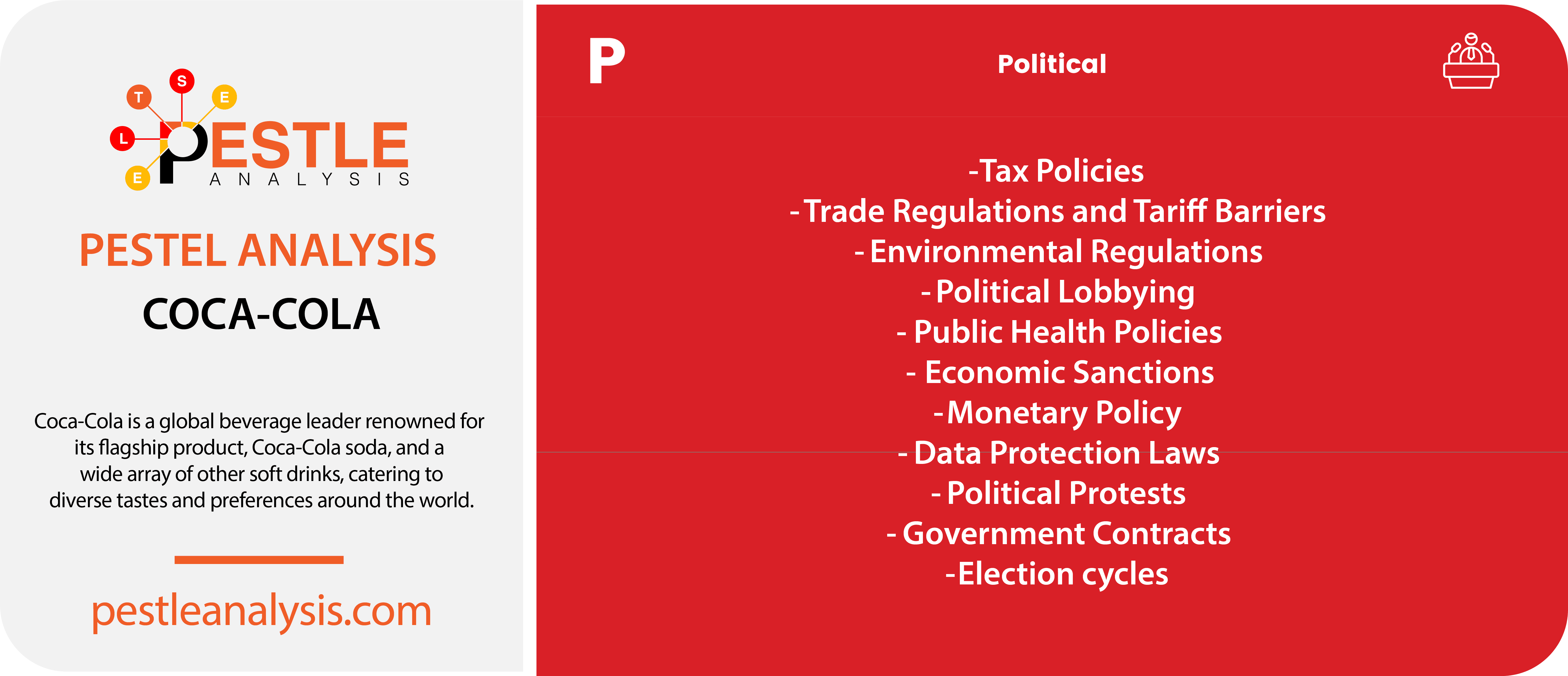
- Tax Policies: Changes in corporate tax rates, sales tax, or other related taxes in countries where Coca-Cola operates can significantly affect their profitability. For instance, higher taxes could increase production costs and reduce margins.
- Trade Regulations and Tariff Barriers: Trade agreements and tariff structures affect Coca-Cola’s cost of exporting and importing goods. For example, an increase in tariffs on imported raw materials like sugar could increase production costs, whereas favorable trade agreements might lower these costs.
- Environmental Regulations: Stricter environmental laws (like those targeting plastic use and greenhouse gas emissions) can impact Coca-Cola's packaging and distribution. Compliance with these regulations might require significant investment in sustainable practices and technologies.
- Political Lobbying: Coca-Cola has engaged in lobbying ever since the early 1900s to influence legislation and regulations that affect its business. Effective lobbying can mitigate the adverse effects of new policies or help shape favorable regulations.
- Public Health Policies: Increasing government focus on health, such as reducing obesity and diabetes, can lead to regulations that affect Coca-Cola, such as taxes on sugary drinks, which could reduce sales volumes.
- Economic Sanctions: Sanctions imposed by countries can disrupt Coca-Cola’s market operations, especially if they are barred from trading with certain countries, impacting revenue streams.
- Monetary Policy: Changes in a country's monetary policy, such as adjustments in interest rates or inflation targets, can impact Coca-Cola’s financial management strategies. For example, if a country lowers interest rates, it might make borrowing cheaper, which can encourage Coca-Cola to invest more in capital projects or expansion within that region. Conversely, high-interest rates may lead to higher borrowing costs and might deter investment. Additionally, monetary policy strongly influences currency value fluctuations, affecting Coca-Cola's profits from overseas markets when repatriated to the home currency.
- Data Protection Laws: Regulations like the EU's GDPR affect how Coca-Cola collects, uses, and stores consumer data. Compliance requires robust data protection measures, potentially increasing operational costs.
- Political Protests: Political protests can impact Coca-Cola both directly and indirectly. Directly, protests can disrupt operations, supply chains, and distribution networks, particularly if they occur in major economic centers or involve infrastructure. Indirectly, significant political unrest might lead to changes in government or policies, affecting the business environment. Long-term unrest can also harm consumer confidence, leading to reduced spending on non-essential goods, including beverages. Moreover, in regions where protests are against corporate entities, multinational corporations like Coca-Cola might face backlash or calls for boycotts, which can affect brand image and sales.
- Government Contracts: Coca-Cola often supplies its products for government events and facilities. Political changes influencing these contracts can affect sales volumes and strategic market positioning.
- Election cycles: Election periods often bring about uncertainty in regulatory environments. Changes in leadership can result in shifts in economic, foreign, and trade policies. For companies like Coca-Cola, which operate on a global scale, this means that strategic planning must account for potential changes in the legal and business environment in key markets. Elections can influence consumer confidence and spending behavior, as well. Political campaigns that promise economic growth and stability can boost consumer spending, potentially increasing sales of consumer goods like beverages. Election cycles often lead to heightened media attention and public engagement, providing both challenges and opportunities for advertising.
Coca-Cola Economic Factors
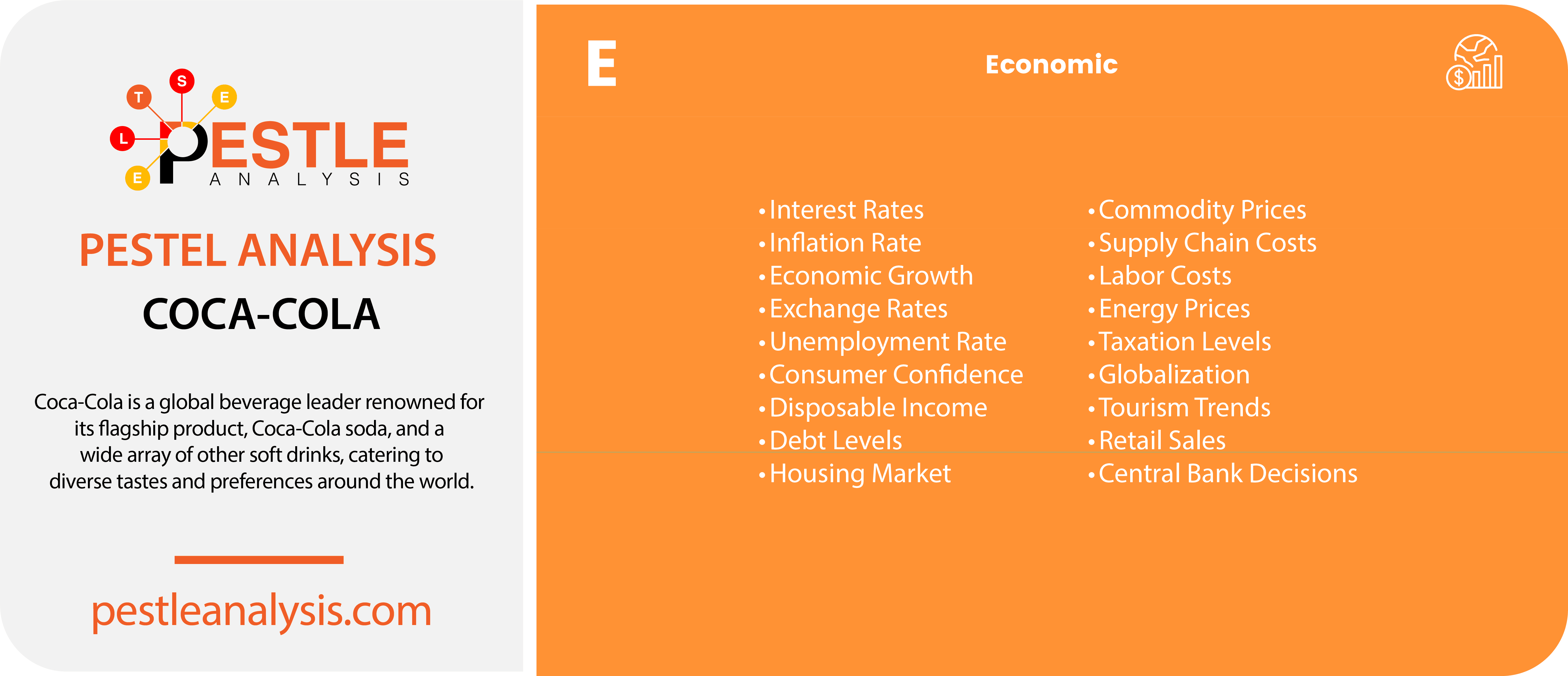
- Interest Rates: Fluctuations in interest rates affect Coca-Cola’s cost of borrowing and financing. Lower interest rates can facilitate cheaper access to capital for expansion or investments, whereas higher rates increase costs and can reduce expenditure on marketing and development.
- Inflation Rate: Inflation influences Coca-Cola’s input costs (like raw materials and labor) and pricing strategies. High inflation may necessitate price adjustments to maintain margins, potentially affecting consumer demand.
- Economic Growth: The level of economic growth in a market influences consumer spending power. In growing economies, Coca-Cola might see increased demand for its products as more consumers can afford discretionary purchases.
- Exchange Rates: Since Coca-Cola operates globally, exchange rate volatility can significantly impact its revenue and profits when foreign earnings are converted back to the home currency. Adverse movements can erode profits, while favorable shifts can provide a boost.
- Unemployment Rate: High unemployment rates typically reduce consumer spending power, impacting demand for non-essential goods like soft drinks. This requires Coca-Cola to adjust its marketing and pricing strategies accordingly.
- Consumer Confidence: The degree of consumer optimism about economic conditions affects their spending habits. Higher confidence boosts purchases of non-essential items, benefiting Coca-Cola.
- Disposable Income: Changes in disposable income levels directly affect Coca-Cola’s sales volumes. Higher disposable income means consumers are more likely to indulge in luxury or non-essential goods such as soft drinks.
- Debt Levels: High consumer or governmental debt levels can lead to austerity measures and reduced consumer spending, negatively impacting demand for Coca-Cola’s products.
- Housing Market: A strong housing market boosts economic confidence and disposable income, often leading to increased consumer spending, which can positively affect Coca-Cola’s sales.
- Commodity Prices: Prices of key commodities like sugar and aluminum affect production costs for Coca-Cola. Rising commodity prices can squeeze profit margins unless offset by pricing strategies or operational efficiencies.
- Supply Chain Costs: Fluctuations in logistics and supply chain costs can impact Coca-Cola’s profit margins. Efficient supply chain management is crucial to mitigating these costs.
- Labor Costs: Increases in labor costs due to wage inflation or regulatory changes can impact Coca-Cola’s operational expenses, affecting overall profitability.
- Energy Prices: Since Coca-Cola’s manufacturing and distribution are energy-intensive, changes in energy prices can significantly affect operational costs.
- Taxation Levels: Changes in corporate, sales, or excise taxes, such as those on sugary beverages, can directly affect Coca-Cola’s bottom line and pricing models.
- Globalization: As a global company, Coca-Cola benefits from globalization through access to emerging markets and expanded consumer bases, though this also exposes the company to global economic shifts and crises.
- Tourism Trends: Tourism can significantly influence demand for Coca-Cola products in tourist-heavy regions. A decline in tourism, possibly due to economic downturns or other factors, can reduce sales.
- Retail Sales: Trends in retail sales indicate overall consumer spending behavior, which directly impacts Coca-Cola’s product sales. Positive retail growth typically signals good conditions for increased product turnover.
- Central Bank Decisions: Decisions by central banks, such as those regarding the money supply and banking regulations, can affect economic stability and consumer spending power in a market. For instance, if a central bank decides to tighten monetary policy leading to reduced money supply, it could decrease consumer spending, affecting sales of discretionary products like soft drinks. Moreover, decisions that affect currency valuation can impact Coca-Cola’s import and export costs, making raw materials more expensive or altering competitive pricing dynamics in foreign markets.
Coca-Cola Social Factors
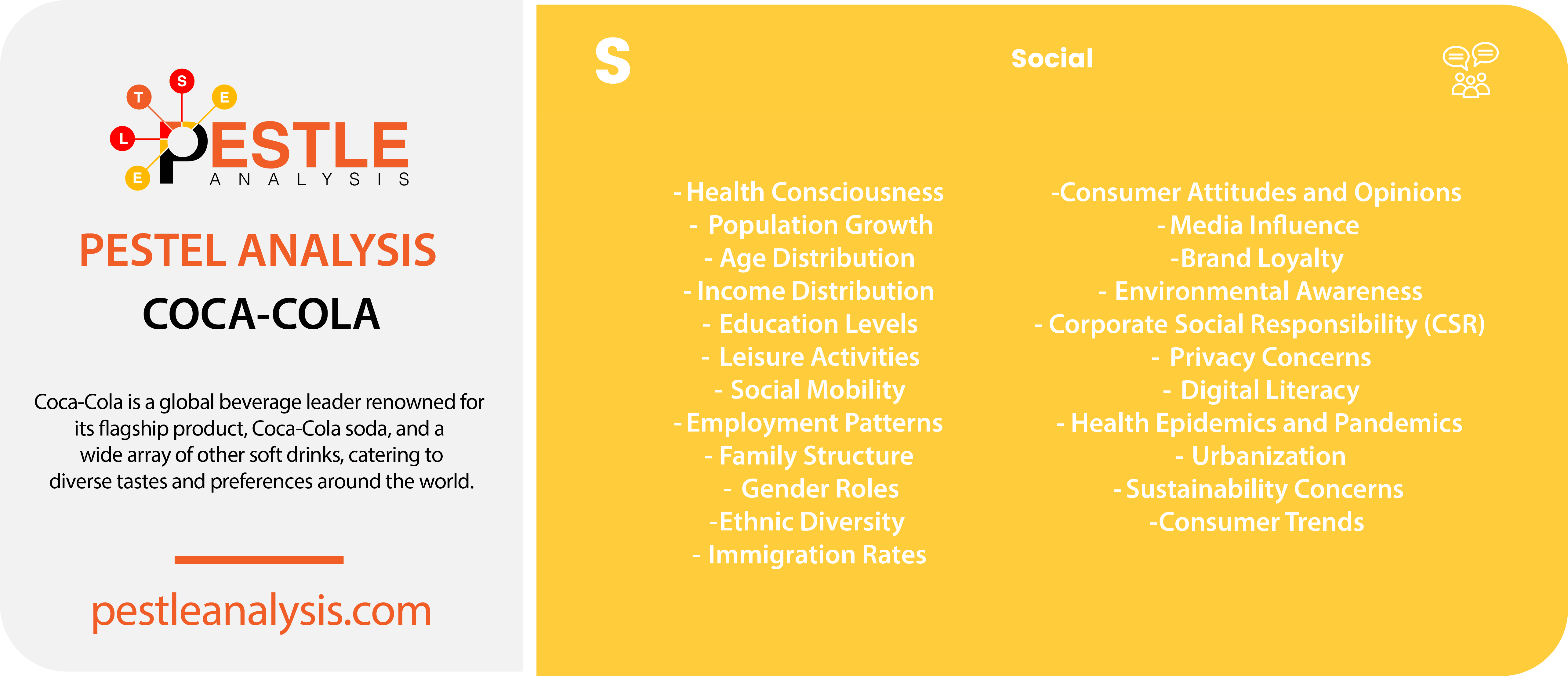
- Health Consciousness: Increased awareness about health and wellness shapes consumer preferences, pushing Coca-Cola to diversify its product line to include low-sugar and sugar-free options, as well as beverages with health benefits like teas.
- Population Growth: As global populations increase, particularly in emerging markets, Coca-Cola sees opportunities for market expansion and increased consumption of its products.
- Age Distribution: Demographic shifts, such as aging populations in developed countries or younger demographics in emerging markets, guide Coca-Cola’s marketing strategies and product development.
- Income Distribution: Variances in income affect consumer purchasing power, influencing Coca-Cola’s pricing strategies and market targeting, especially in regions with significant income disparities.
- Education Levels: Higher education levels can lead to greater health consciousness and environmental awareness, impacting the types of products consumers demand from beverage companies.
- Leisure Activities: Trends in leisure and lifestyle can dictate the demand for certain types of beverages, such as sports drinks in active communities or ready-to-drink teas in areas where relaxation is a cultural norm. On April 30, 2024, the company raised its sales forecast, as consumers going out to the movies and dining were willing to spend more on its soft drinks.
- Employment Patterns: Employment trends, such as the rise in gig economy jobs, influence when and how consumers purchase beverages, potentially shifting demand towards convenience and on-the-go consumption.
- Family Structure: Shifts towards smaller family units or changes in household roles influence purchase decisions and consumption patterns, affecting how Coca-Cola markets its products.
- Gender Roles: Evolving gender roles can lead to changes in who makes purchasing decisions in households, influencing Coca-Cola’s advertising and promotional efforts.
- Ethnic Diversity: Coca-Cola tailors its products and marketing campaigns to cater to diverse ethnic groups, incorporating local flavors and cultural preferences in its product offerings.
- Immigration Rates: High rates of immigration can introduce new tastes and preferences into a region, prompting Coca-Cola to adapt its product range to suit diverse palates.
- Consumer Attitudes and Opinions: Public sentiment about health, environment, or corporate responsibility can significantly influence Coca-Cola’s brand image and necessitate adjustments in corporate strategies.
- Media Influence: Media plays a crucial role in shaping consumer perceptions and trends, which Coca-Cola leverages through advertising and public relations campaigns.
- Brand Loyalty: Coca-Cola heavily invests in maintaining customer loyalty through consistent branding, customer engagement, and loyalty programs.
- Environmental Awareness: Growing consumer demand for sustainable practices has led Coca-Cola to invest in eco-friendly packaging and water conservation initiatives.
- Corporate Social Responsibility (CSR): Coca-Cola’s CSR activities, which focus on community engagement, environmental sustainability, and economic development, help improve its public image and consumer trust.
- Privacy Concerns: In an era where data privacy is paramount, Coca-Cola ensures compliance with global data protection regulations to maintain consumer trust.
- Digital Literacy: As digital platforms become the norm for consumer interactions, Coca-Cola enhances its digital marketing strategies to better connect with tech-savvy consumers.
- Health Epidemics and Pandemics: Events like the COVID-19 pandemic require Coca-Cola to adapt its marketing and distribution strategies to changing consumer behavior and restrictions.
- Urbanization: Increasing urbanization drives demand for convenience products, including Coca-Cola’s beverages, influencing distribution strategies to focus more on urban centers.
- Sustainability Concerns: Consumer preference for sustainable brands influences Coca-Cola to emphasize its recycling and sustainable resource use more prominently in its operations and marketing.
- Consumer Trends: Keeping pace with fast-evolving consumer trends is crucial for Coca-Cola to remain relevant, requiring continual innovation in product development and marketing strategies.
Coca-Cola Technological Factors
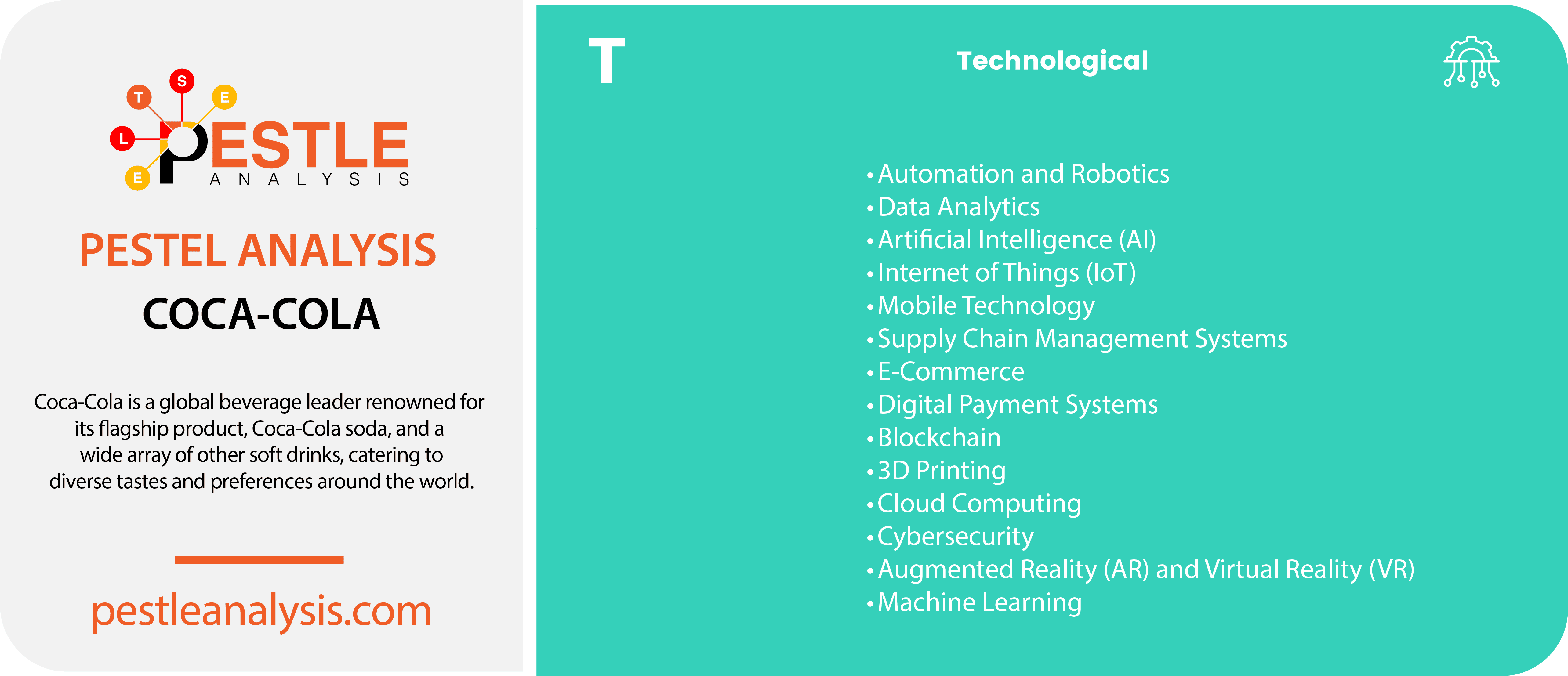
- Automation and Robotics: The use of automation and robotics in manufacturing increases efficiency and reduces costs. Coca-Cola uses these technologies in its bottling and packaging processes to ensure high throughput and consistent product quality.
- Data Analytics: Advanced data analytics enable Coca-Cola to understand consumer preferences, optimize supply chains, and enhance marketing strategies. Leveraging big data helps Coca-Cola make informed decisions and personalize marketing efforts.
- Artificial Intelligence (AI): AI technologies help Coca-Cola in various domains, including consumer interaction, predictive maintenance for machinery, and optimizing delivery routes. AI also plays a role in market analysis and trend forecasting.
- Internet of Things (IoT): IoT devices are used in Coca-Cola's manufacturing plants to monitor equipment performance and in vending machines to track inventory and maintenance needs. This technology improves operational efficiency and customer service.
- Mobile Technology: Mobile platforms are crucial for marketing and sales. Coca-Cola engages customers through mobile apps, social media, and targeted advertising, enhancing customer engagement and driving sales.
- Supply Chain Management Systems: Advanced supply chain management technologies help Coca-Cola maintain efficient operations, manage global logistics, and minimize disruptions, ensuring timely delivery of products across vast networks.
- E-Commerce: The growth of online shopping has pushed Coca-Cola to strengthen its e-commerce presence, offering products through online retailers and developing direct-to-consumer platforms.
- Digital Payment Systems: The adoption of digital and contactless payment methods in Coca-Cola vending machines and sales points caters to consumer preferences for convenience and safety.
- Blockchain: Coca-Cola utilizes blockchain technology for supply chain transparency, helping to manage the complexities of the global supply network and ensuring ethical sourcing practices.
- 3D Printing: Although still in early stages of application, 3D printing technology offers potential for producing custom marketing materials and even prototyping new bottle designs.
- Cloud Computing: Coca-Cola relies on cloud technology for data storage, customer relationship management (CRM), and enterprise resource planning (ERP) systems, which support global operations and real-time data access.
- Cybersecurity: As Coca-Cola increasingly digitizes its operations, ensuring robust cybersecurity measures is critical to protect sensitive company and consumer data from cyber threats.
- Augmented Reality (AR) and Virtual Reality (VR): These technologies are used in marketing to create engaging brand experiences. For example, AR campaigns that allow consumers to interact with the brand in innovative ways.
- Machine Learning: Coca-Cola can use machine learning algorithms for consumer behavior analysis, sales forecasting, and optimizing marketing campaigns, which allows for more efficient resource allocation and targeted advertising.
Coca-Cola Legal Factors
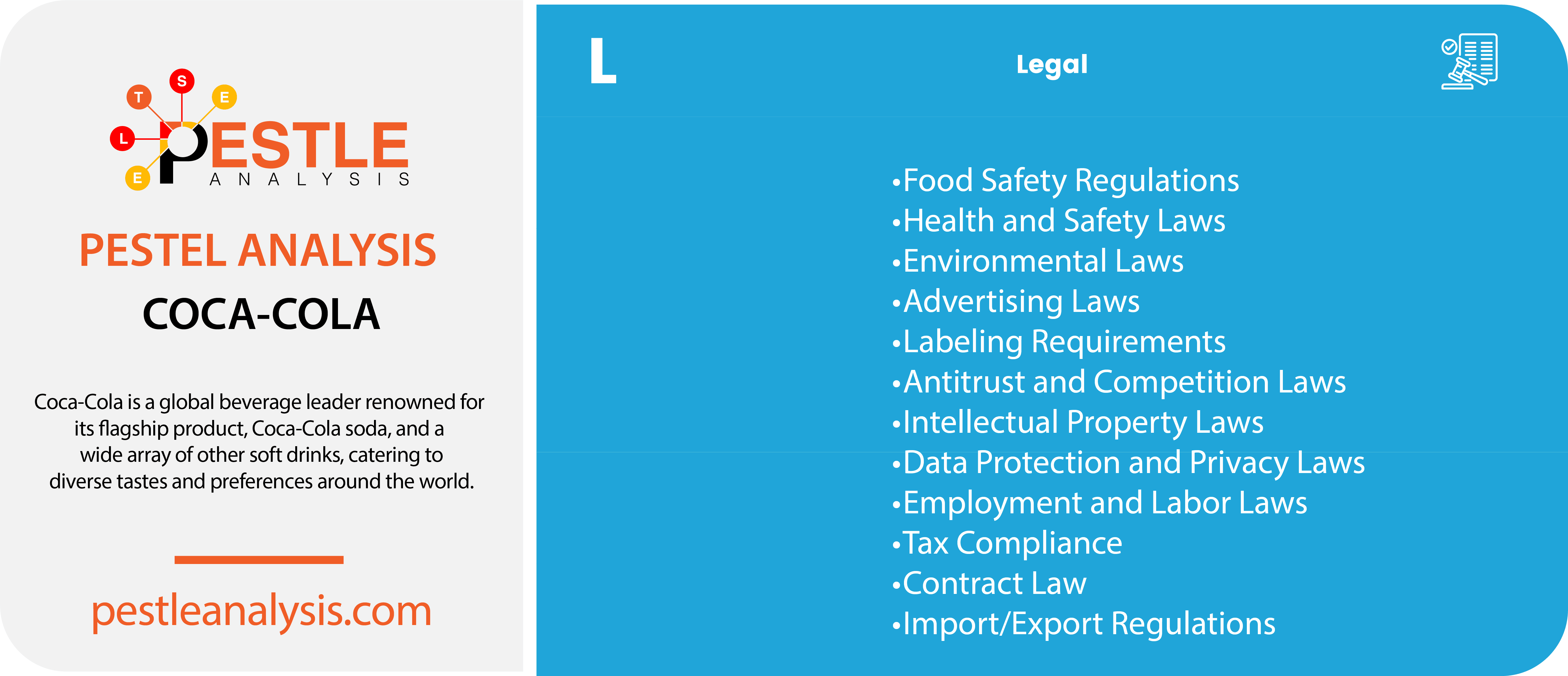
- Food Safety Regulations: Coca-Cola must adhere to stringent food safety standards that govern the production, packaging, and distribution of food and beverages. Compliance with these regulations is critical to maintain product quality and consumer trust.
- Health and Safety Laws: Ensuring the health and safety of employees in factories and offices is mandated by law in many countries. Coca-Cola is required to comply with these regulations to avoid legal liabilities and protect its workforce.
- Environmental Laws: These include regulations related to waste management, emissions, and resource usage. Coca-Cola has to ensure its operations do not exceed the legal thresholds for environmental impact, necessitating investments in eco-friendly technologies and practices.
- Advertising Laws: Advertising and marketing practices are tightly regulated, especially around claims regarding health benefits, product ingredients, and marketing to children. Coca-Cola must navigate these laws to prevent misleading advertising and ensure compliance.
- Labeling Requirements: Legal requirements for product labeling include nutritional information, ingredient lists, and allergen declarations. Coca-Cola needs to ensure all its product labels are compliant with local and international standards to avoid legal issues.
- Antitrust and Competition Laws: As a dominant player in the beverage industry, Coca-Cola must carefully comply with antitrust laws designed to prevent monopolistic practices and promote fair competition. This includes how it manages its relationships with suppliers and retailers.
- Intellectual Property Laws: Protecting trademarks, patents, and copyrights is crucial for Coca-Cola to safeguard its brand and proprietary products from infringement, ensuring its formulas and branding remain exclusive.
- Data Protection and Privacy Laws: With the increasing digitization of customer interactions, Coca-Cola must adhere to strict data protection laws, such as GDPR in Europe, to manage consumer data responsibly and maintain customer trust.
- Employment and Labor Laws: These laws cover worker rights, including wages, working hours, non-discrimination, and unionization. Coca-Cola must ensure its employment practices are fair and legal across all regions it operates in.
- Tax Compliance: Coca-Cola must navigate complex tax laws and regulations in all the jurisdictions it operates. This includes complying with international tax laws and transfer pricing regulations to avoid disputes with tax authorities.
- Contract Law: The company engages in numerous contracts with suppliers, distributors, and retailers. Ensuring that these contracts are legally sound and enforceable under various jurisdictions is vital to secure business operations.
- Import/Export Regulations: Coca-Cola must comply with international trade laws that govern the import and export of goods, including tariffs, trade barriers, and customs regulations.
Coca-Cola Environmental Factors
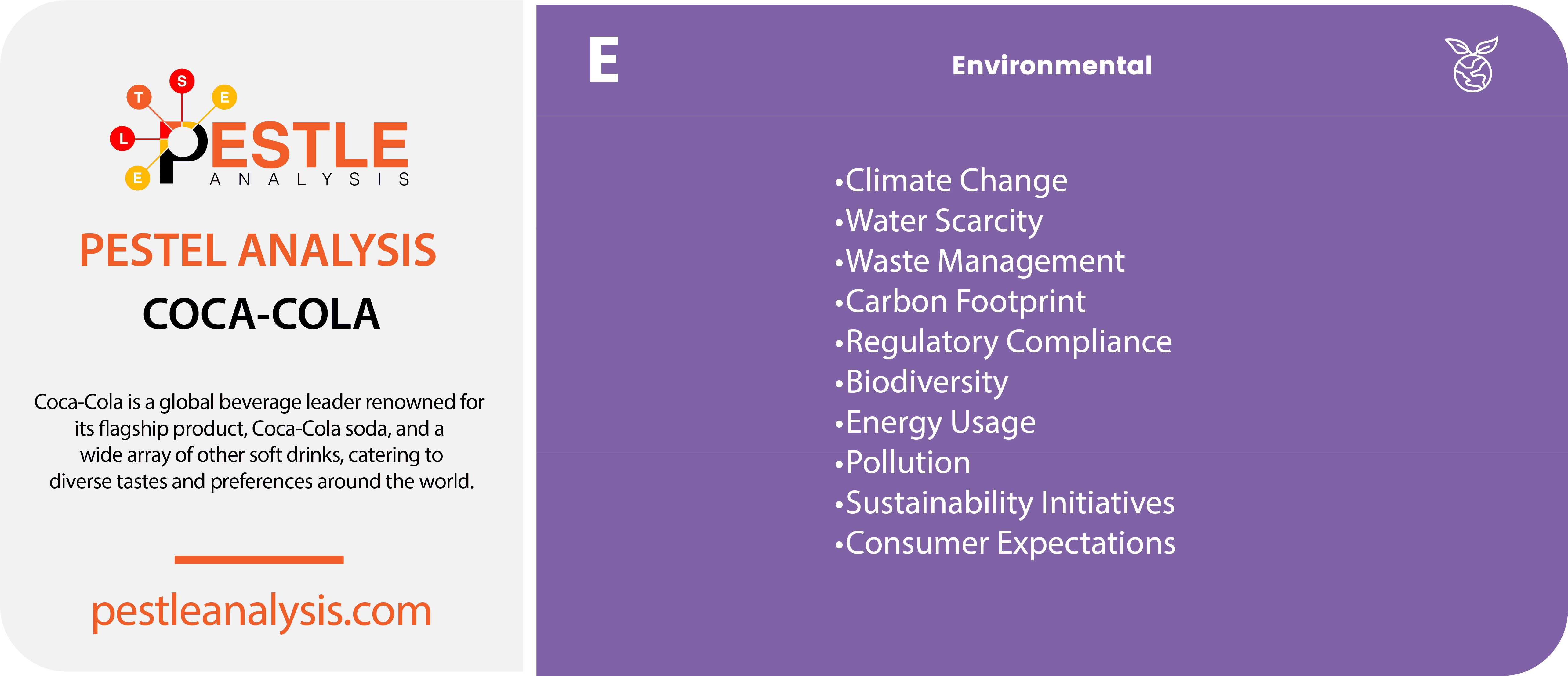
- Climate Change: Changes in climate affect water resources and agricultural productivity, directly impacting Coca-Cola's water supply and the availability of key ingredients like sugar cane and citrus fruits. Coca-Cola must adapt to these changes through sustainable water management and sourcing practices.
- Water Scarcity: As a major user of water, Coca-Cola faces challenges in regions experiencing water shortages. The company needs to implement and innovate water-efficient technologies and practices to ensure sustainable water use and to maintain its social license to operate.
- Waste Management: The production and disposal of packaging materials, particularly plastic, are significant environmental concerns. Coca-Cola is moving towards more sustainable packaging solutions, including recycling programs and the development of biodegradable and more environmentally friendly packaging options.
- Carbon Footprint: The global push towards reducing carbon emissions affects how Coca-Cola manages its manufacturing and distribution processes. Initiatives to reduce the carbon footprint include optimizing transportation routes, using energy-efficient technologies, and transitioning to renewable energy sources.
- Regulatory Compliance: Coca-Cola must comply with a broad range of environmental regulations across different regions, including emissions standards, recycling requirements, and waste disposal norms. Failure to comply can result in fines, sanctions, and damage to the company’s reputation.
- Biodiversity: Coca-Cola’s operations can impact local ecosystems and biodiversity, especially in areas where raw materials are sourced. The company needs to ensure that its supply chain practices promote biodiversity conservation and sustainable use of resources.
- Energy Usage: Operational efficiency in terms of energy use is crucial for reducing costs and minimizing environmental impact. Coca-Cola is investing in more energy-efficient manufacturing processes and exploring renewable energy sources like solar and wind.
- Pollution: Manufacturing processes can lead to air and water pollution. Coca-Cola is tasked with implementing pollution control measures to minimize the environmental impact of its operations, adhering to both local and international standards.
- Sustainability Initiatives: Coca-Cola is actively involved in various sustainability initiatives to enhance its corporate responsibility profile and engage with environmentally conscious consumers. These include partnerships with environmental organizations and commitments to global sustainability goals.
- Consumer Expectations: Increasingly, consumers demand that companies demonstrate environmental responsibility. Coca-Cola must align its brand and operations with these expectations to maintain customer loyalty and brand value.
Coca Cola PESTLE Analysis: Further Research
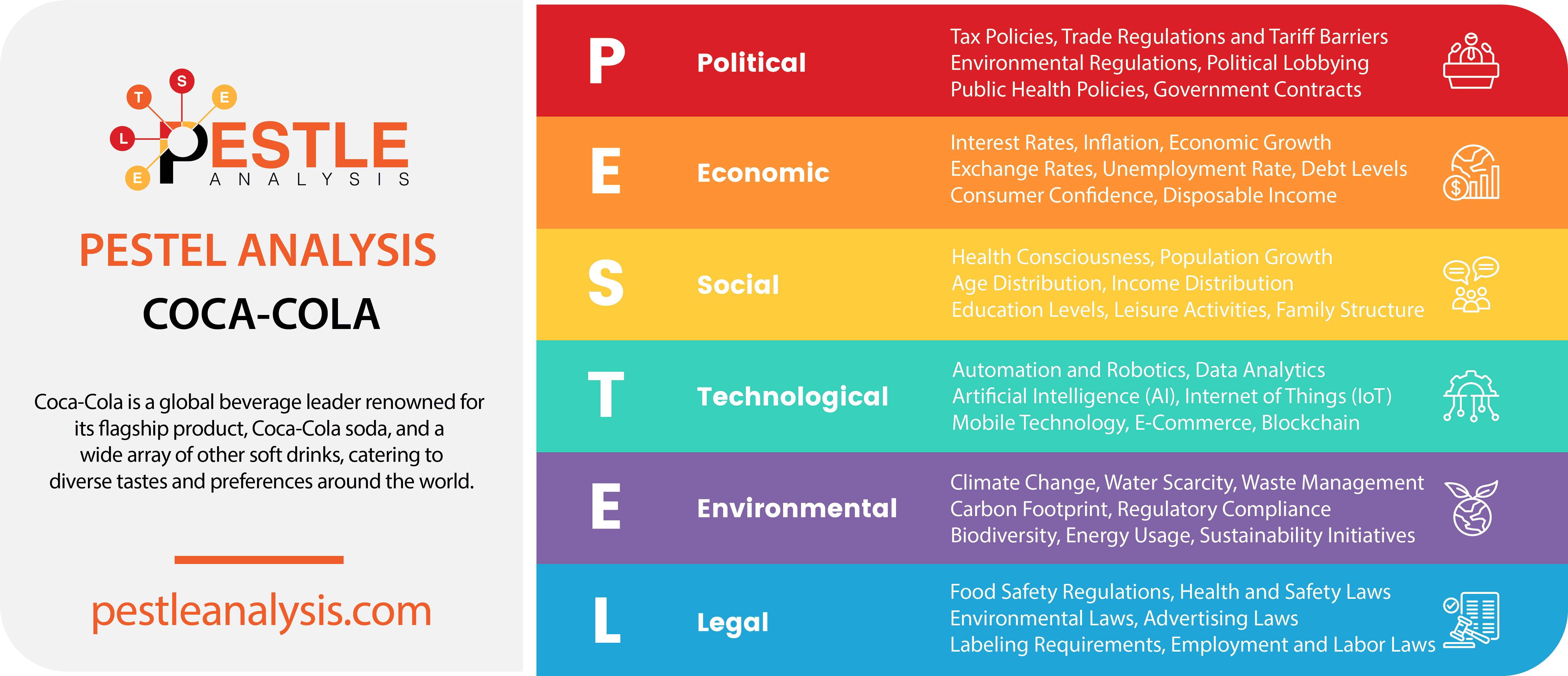
And that's a wrap for our PESTLE analysis of Coca-Cola! If you want to know more about this strategic tool, visit our dedicated page on PESTLE analysis here. Now, you may want to continue your research by checking out our SWOT analysis of Coca-Cola or our analysis of some of Coca-Cola's main competitors below:
- PESTLE Analysis of PepsiCo
- PESTLE Analysis of Red Bull
- PESTLE Analysis of Nestlé
- SWOT Analysis of Energy Drinks

